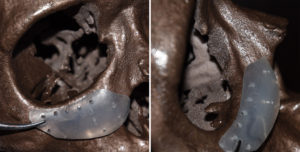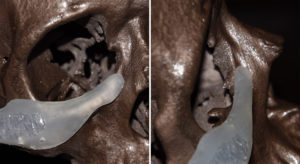The undereye area has become a focus of aesthetic attention for the management of tear troughs and hollows. Some of these occur as a result of aging and others have a more congenital origin which then becomes more apparent with aging. Treatment for aesthetic under eye issues is fundamentally about adding volume. Injectable fillers and fat are the mainstays of this volume addition with the adjunctive use of lower blepharoplasty skin removal if needed.
While the injectable management of undereye contour issues cam be very effective, it does not work well for some patients. It is particularly ineffective for true infraorbital bone underdevelopment which is associated with a negative orbital vector. In these cases an infraorbital rim bone augmentation using an implant would be best. While a surgical procedure it provides permanent smooth rim augmentation whose volume retention is assured.


Custom infraorbital rim implants can also be made to just cover the infraorbital rim area only, providing vertical rim augmentation. (type 3 infraorbital rim implant) This is the least commonly used type of infraorbital rim implant. Such isolated vertical augmentation could only be effectively done in a custom made process.
Augmentation of the infraorbital rim area can not be accomplished with a single implant style for the range of anatomic deformities that occur and to achieve satisfactory aesthetic outcomes. Understanding the differing options of this unique facial implant can be a good complement to injectable treatment strategies.
Dr. Barry Eppley
Indianapolis, Indiana


